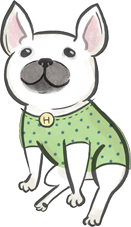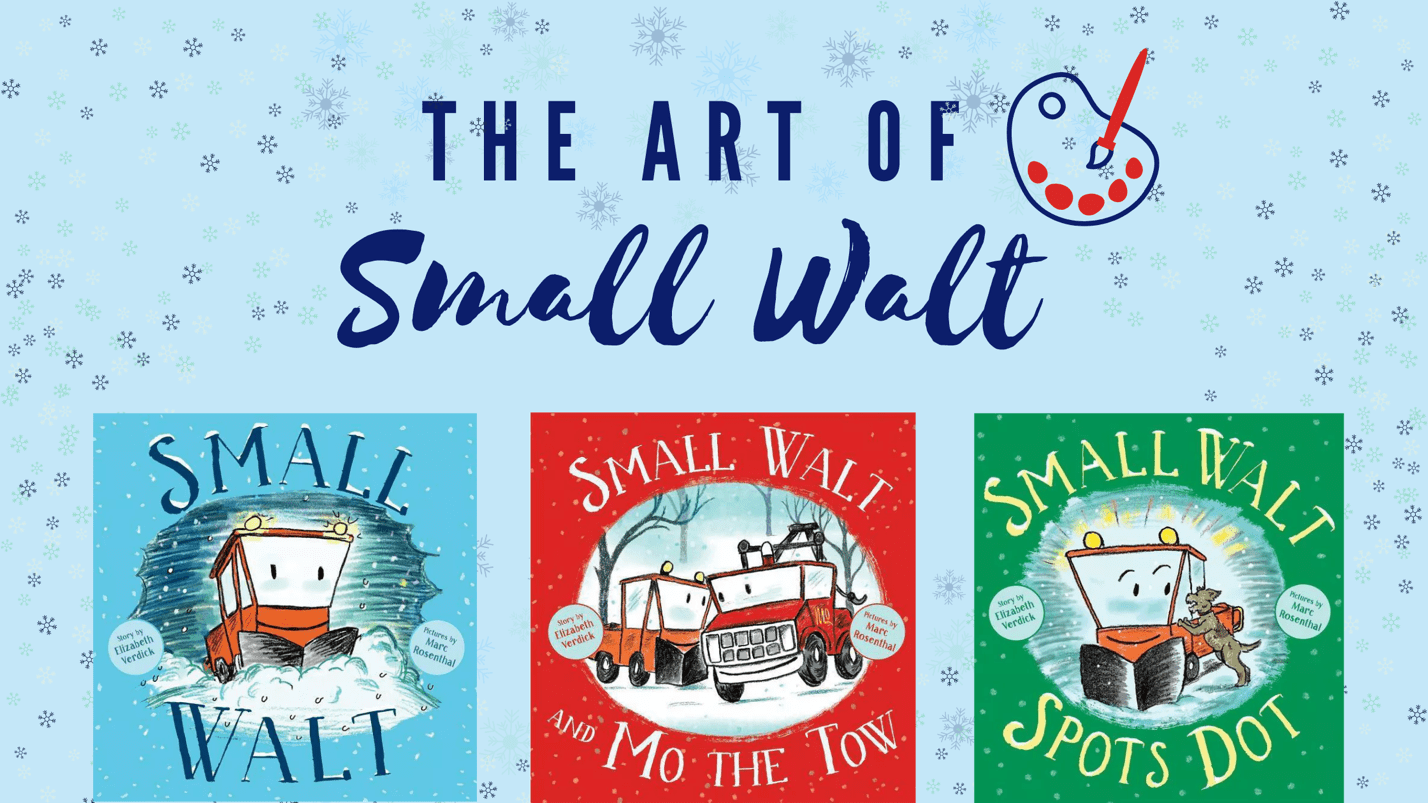
As a picture book author, I get a little bit of an insider’s view of how children’s books are put together—but just a peek. Authors and illustrators work separately, with the publisher, editor, and designer as the go-between. So, for all these years of working with Marc, I’ve never actually had the pleasure of meeting him in person. I thought it would be fun to interview him about his work as an artist. I wanted that insider’s view so I could share it with you.
Elizabeth: I’ve always wondered what your studio looked like. Can you describe it?
Marc: My studio is on the third floor of our house in the Berkshires, in what was once the attic. When we moved in, we insulated it, adding big windows and a skylight. The space is very light (sometimes too light!). There are bookshelves running along the south side under the windows. It is full of art books, design books, and children’s books. I have a drawing table in the center of the room and a computer off to the side. I love to work, so I spend most of my time up there. In past years, most of my work was for magazines and newspapers. That work has dropped off a bit, so when I’m not working on a book or an assignment, I am usually painting. I’ve rediscovered oil painting (my original love) and now feel like a novice again.
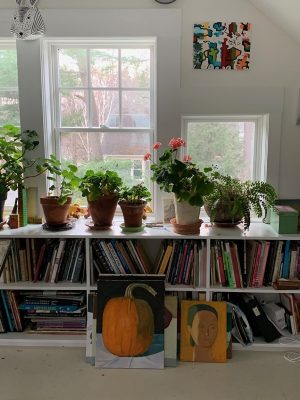 Elizabeth: We’ve worked together on three books—Small Walt, Small Walt and Mo the Tow, and Small Walt Spots Dot. I’m always amazed when a picture book artist can take a writer’s brief words and then build an entire visual story from them. How do you do that? How do the words inspire you?
Elizabeth: We’ve worked together on three books—Small Walt, Small Walt and Mo the Tow, and Small Walt Spots Dot. I’m always amazed when a picture book artist can take a writer’s brief words and then build an entire visual story from them. How do you do that? How do the words inspire you?
Marc: I think the job of the picture book artist is to expand on the writer’s words. In picture books, the words tend to be sparse, carefully chosen, like poetry. The illustrator’s job is to visually flesh out the words and to provide enough visual interest to encourage multiple readings. And maybe to add an extra level of meaning to the characters and story. I look for the feeling and the setting that the author provides. I try to create a visual space that I would want to live in. In Small Walt, I pictured a small town.
Elizabeth: When I was first writing Small Walt, I didn’t picture a small town; more like a city with big plows and snow flying everywhere. To help the writing process I’d put a photo of a yellow plow on a piece of paper and add “googly eyes” to make it seem like a character. Here’s what’s so amazing about the picture-book making process: you took the words of my story and created a whole illustrated world, complete with a small town, an adorable red-orange Walt, and a cast of human and vehicle characters. When I first saw your color art of Walt, I was like, “Oh! So that’s what he looks like.” I was completely charmed. Can you talk a bit about how you visualize your characters, and what your sketching process is like?
Marc: I often model characters after people I know. Gus (Walt’s driver) was based on an old friend: a talented woodworker, an agreeable guy, laid back and maybe a bit unconventional. Sue, the driver of Mo the Tow, is another friend. Sometimes I will Google images of people. The community officer in Small Walt Spots Dot was a combination of some actual policewomen and Frances McDormand from the movie Fargo. To create the various vehicles in the books, I looked at snowplows and trucks online and found a small sidewalk snowplow in our town (for Walt) and followed it around and took pictures. I do a lot of pencil sketches before I can refine it toward a finish.
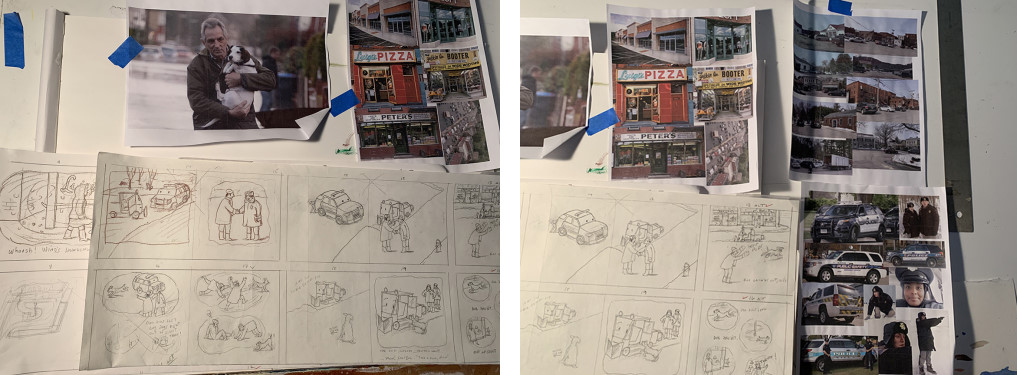
Elizabeth: Many people have remarked that the illustrations in the Small Walt books have a kinship to the work of Virginia Lee Burton and yet have a modern quality all their own. Were you influenced by Burton’s work? What are some of your other illustrator influences?
Marc: Virginia Lee Burton—you nailed it! I have always been attracted to the styles of the 1930s and 1940s. Maybe it’s because I grew up watching Marx Brothers movies and love the picture books I grew up with and the worlds they created. I actually love the look of limited color lithographic reproduction, but I usually can’t get away with it these days. My other big artistic influences are Jean de Brunhoff (Babar), Ludwig Bemelmans (Madeline), and Robert McCloskey. (I literally borrowed an image from his classic book Make Way for Ducklings for my book Phooey!)
Elizabeth: Can you talk about the color palette you chose for the books? And the medium you use for these works? How did these choices come about?
Marc: The Walt books have a little different palette than I am used to using. Often, I will go for the look of old Sunday comics on yellowed newsprint. For the Walt books, I needed a bluish wintery cast. Though I began my career using watercolor, recently I have moved to digital color. Publishers want artwork delivered digitally, so it made sense to create it digitally. To achieve that wintery feeling, I gave each image an underlay of pale blue that bleeds through all the colors. In the work, I always start with an actual drawing in pencil or ink. This is scanned, and then color is added.
Elizabeth: When you’re illustrating a picture book, do you work on the pages in chronological order? Or maybe find the story’s dramatic climax and focus on that first?
Marc: When I first see the story, it is usually just a few pages of text. First, I try to think of it in terms of pages or spreads. I also consider pacing—where are the page turns, when should there be lots of little images on a page, and when do we need a big double-page spread. I go back and forth with the editor (in this case, Sylvie Frank of Paula Wiseman Books) about this. There’s also lots of fussing to make it fit into a 32-page picture book. I do the work in chronological order because I want to feel the flow of the story. The important moments are revealed this way. While working with the talented designer of all the Small Walt books (Lizzy Bromley), the art direction and feedback was spot on and resulted in better books each time.
Elizabeth: I noticed that the name Doris occasionally appeared in the art of our story Small Walt Spots Dot…do you want to share who Doris is?
Marc: I’m glad you noticed Doris! Doris is the name of my new grandniece. It was also my mother’s name. Over the years, I have managed to sneak the names of my son, Will, and his cousins, Malcolm and Maggie, into almost all of my books. Once, I even put the name of my son’s best friend, Colin, into a book. It started to get out of hand, so for now “Doris” will be it.
Elizabeth: Thank you sharing your creative process with me. I am especially excited about the newest book, Small Walt Spots Dot, because you got to add a furry friend for Walt (Dot). My furry “writing assistant,” Hugo, was the inspiration for some of Dot’s antics.
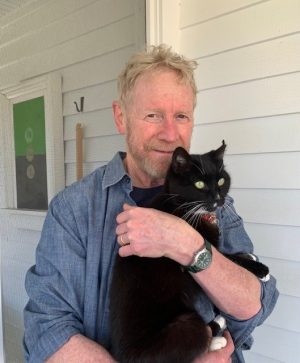 |
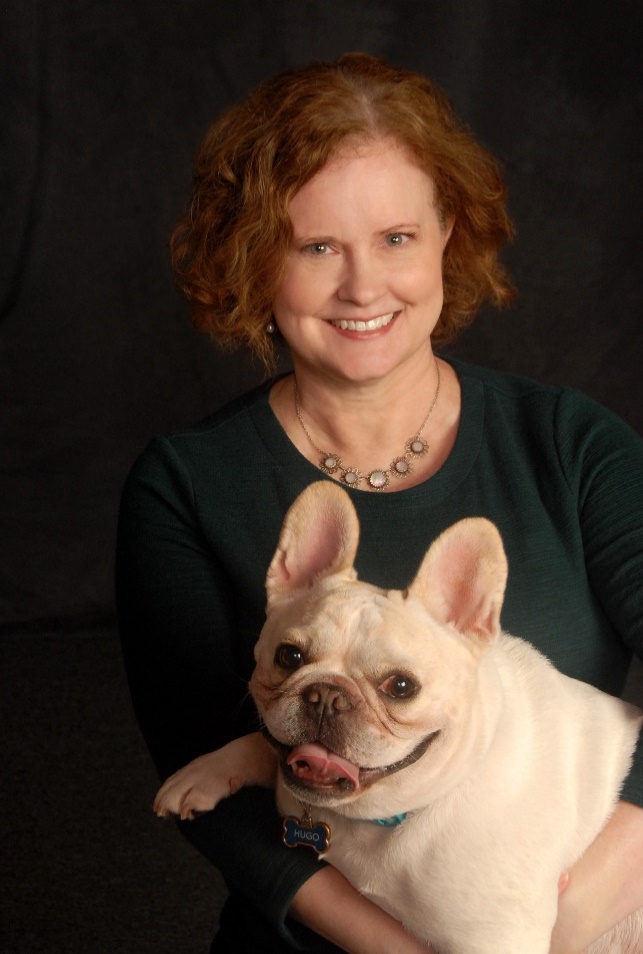 |
For more information about the Small Walt books, please visit Simon & Schuster.
Or, order from your local independent bookseller.

